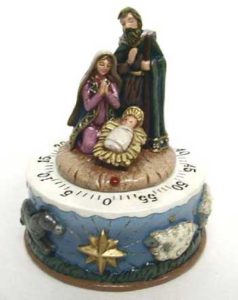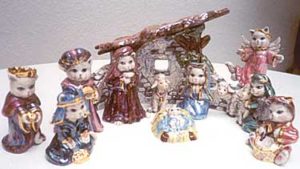Want to venerate the Holy Family but don’t want the pot to boil over? Try this crèche on a timer.
According to Samuel Johnson
“We must either outlive our friends you know, or our friends must outlive us; and I see no man that would hesitate about the choice.”
According to Karen Lamb
“A year from now you will wish you had started today.”
Hideous Nativity 3
According to Carl Sandburg
“Time is the coin of your life. It is the only coin you have, and only you can determine how it will be spent. Be careful lest you let other people spend it for you.”
Hideous Nativity Scenes 2
Hideous Nativity Scenes 1
The creation of nativity scenes is an ancient and global phenomenon. Some, like those made for Neapolitan royalty in the 18th century, are gorgeous; others are imaginative but not always in good taste. We will feature some of those over the next week.
Depicting the Holy Family as animals in apparently in vogue. Here they are as dogs, ducks, and cats.
According to David Warren
The Christian must be aware that he is moving towards a destination; and that the destination is not in this world. He must maintain a certain detachment from the things of this world; a chaste detachment; for where he is going cannot be here. Spectator and witness, perhaps actor in his turn, in some role for which he is or isn’t suited; bearing responsibilities to others in every single case. His suffering may be of more value than any achievement to which he may claim. He cannot vest his hopes in earthly things, knowing they will vanish. His finest possessions are not of this world, but from another: the phenomena of reciprocated love; of truth, goodness, and beauty apprehended, preciously kept in the purse of memory; of “news from a foreign country” received. This is all he will hold at the end of his journey, when his road through space and time lies behind him, and everything he once carried on his back has been used up, thrown or taken away, and even the old bag of his flesh is discarded.
According to Michael Oakeshott
To be conservative is to prefer the familiar to the unknown, the tried to the untried, fact to mystery, the actual to the possible, the limited to the unbounded, the near to the distant, the sufficient to the superabundant, the convenient to the perfect, present laughter to utopian bliss.
According to Samuel Johnson
On the same theme as Willa Cather, yesterday’s quote:
So different are the colours of life, as we look forward to the future, or backward to the past; and so different the opinions and sentiments which this contrariety of appearance naturally produces, that the conversation of the old and young ends generally with contempt or pity on either side. To a young man entering the world, with fulness of hope, and ardour of pursuit, nothing is so unpleasing as the cold caution, the faint expectations, the scrupulous diffidence which experience and disappointments certainly infuse; and the old man wonders in his turn that the world never can grow wiser, that neither precepts nor testimonies can cure boys of their credulity and sufficiency; and that not once can he be convinced that snares are laid for him, till he finds himself entangled.
Thus one generation is always the scorn and wonder of the other, and the notions of the old and young are like liquors of different gravity and texture which never can unite. The spirits of youth, sublimed by health and volatized by passion, soon leave behind them the phlegmatic sediment of weariness and deliberation, and burst out in temerity and enterprise. The tenderness, therefore, which nature infuses, and which long habits of beneficence confirm, is necessary to reconcile such opposition: and an old man must be a father to bear with patience those follies and absurdities which he will perpetually imagine himself to find in the schemes and expectations, the pleasures and sorrows of those who have not yet been hardened by time and chilled by frustration.







